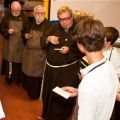ROM leads tour of Toronto’s ‘Sacred Stones & Steeples’
By Vanessa Santilli-Raimondo, The Catholic Register(UPDATED 17/10/2012)
TORONTO - It’s not common knowledge the Catholic Church in Toronto originally owned a plot of land at the northeast corner of George and Adelaide Streets. At that time in 1806, Toronto, then called York, had a Catholic population of about 37 people. Nor do most people know the chapel built on this spot was taken over by soldiers during the War of 1812. The land was eventually sold in order to buy the property where St. Paul’s Basilica stands today.
“The only research is in the deeds to the land which was bought by a priest and it was recorded there to be left entrusted to the Roman Catholic Church,” said Paul Vaculik, a ROMwalks volunteer tour guide.
On Oct. 7, more than 60 people gathered to take part in the Sacred Stones & Steeples ROMwalks guided tour, led by volunteers of the Royal Ontario Museum. The two-hour walk covered landmark religious buildings in Toronto at the tine of the War of 1812, whose bicentennial takes place this year, as well as general historical factoids as time marched onwards.
Along with the origins of St. Michael’s Cathedral, the tour also stopped at St. James Cathedral, Metropolitan United Church, Mackenzie House, St. George’s Greek Orthodox Church and the First Evangelical Lutheran Church of Toronto.
St. Michael’s Cathedral, the oldest church on the tour, was built to accommodate the Catholic population which was growing along with the overall population of Toronto, said Vaculik. St. Paul’s, the first Catholic church in Toronto, was originally fairly small, unlike the basilica Torontonians know today.
“The population really grew because of the famine in Ireland,” he said. “The population of Toronto was 20,000 and, within five months, 38,000 Irish came over.”
Unlike the Anglicans, the Catholic Church’s main base wasn’t the affluent. It was the labourers.
“When they started building around 1847, it was like a barn-raising,” said Vaculik. “A lot of the labourers contributed their labour to building the church so they excavated the land and they started to build the church.”
The base material was ballast material from ships, he added. Bishop Michael Power received a lot of flak for choosing St. Michael’s location, Vaculik said. “It was at the northern end of Toronto and it was starting to get into the boonies, but now it’s well in the heart of Toronto.”
Vaculik also pointed out the often overlooked fact that the galero of Cardinal James McGuigan is hanging above the altar at St. Michael’s Cathedral.
“The tradition was that when the cardinal’s received their hat when they were made cardinals, when they died they would hang their hat up by the ceiling (until) it rotted and fell down.”
This practice has been discontinued, and so, the galero of McGuigan will be the last to hang in the cathedral, he said.
Amidst a backdrop of organ practice, the group was led into the Anglican St. James Cathedral, where a white bust of Bishop John Strachan greeted visitors.
A major influence in Toronto, Strachan played a role in the 1813 surrender of York, negotiating directly with the Americans despite having no official diplomatic authority. In the area of education, Strachan was responsible for establishing King’s College at the University of Toronto.
Unbeknownst to the average churchgoer, the Gothic architecture of the cathedral displays windows in groupings of three to represent the Holy Trinity, said Vaculik.
At Metropolitan United Church, another prominent name in post-secondary education in Toronto is mentioned: Methodist minister Egerton Ryerson.
“Ryerson laid down the framework for the educational system as we know it today,” said Vaculik, including the now standard notion that teachers must complete training colleges.
For more on ROMwalks tours, see www.rom.on.ca/programs.
Catechism, at 20, maintains importance as a resource for Catholics
By Vanessa Santilli-Raimondo, The Catholic RegisterThe Catechism of the Catholic Church is the best comprehensive presentation of the Catholic faith in hundreds of years, said Vancouver Archbishop Michael Miller.
"It's the distillation of the teaching of the Second Vatican Council," said Miller.
The 20th anniversary of the promulgation of the Catechism of the Catholic Church runs parallel to the Year of Faith, which kicked off Oct. 11.
Today, the catechism is used in various settings, including RCIA programs, upper- level high school or college courses, study groups and as a personal reference tool, said Miller.
"And references are constantly made to it in books that you read on homiletics and preaching."
It's an important resource because it brings together the core teachings of the Catholic Church under three categories: the Church's doctrinal positions, Christian practices and worship, said Michael Attridge, a theology professor at Toronto's University of St. Michael's College.
But if people believe the only thing necessary to live a good, full Catholic life is to read the catechism, that is a downside, said Attridge.
"People need to study the Bible, they need to involve themselves in parish organizations, organizations that promote social justice, they need to educate themselves by going to theological school and to ask questions that relate to faith and Christian living."
Since its creation, the publications service of the Canadian Conference of Catholic Bishops (CCCB) has sold 222,787 copies of the catechism in English and French, said René Laprise, director of media relations for the CCCB. In addition, 45,673 copies of the Compendium of the Catechism of the Catholic Church have been sold through the CCCB.
"A number of copies have been sold through Canadian bookstores and direct sales from publishers in the United States and France, although we have no way of determining how many," said Laprise.
Miller added that in the archdiocese of Vancouver, there's currently a big push on YOUCAT: The Youth Catechism of the Catholic Church.
"We've distributed more than 10,000 copies of YOUCAT to parishes because it's in some ways far more accessible and user-friendly for the level of knowledge of religion that most people have."
Had it not been for the anniversary of the catechism, Miller doesn't think the arch-diocese would have come up with such an initiative. And while the catechism is the standard, he said he believes YOUCAT is more in tune to how people today learn and read.
"As much as we might lament the loss — as I do — of plunging through big books, most people today read in small bits and they're used to more pictorial representations... It's just the way things are. I think it's far more effective."
Manitoba releases Canada’s first spiritual care plan
By James Buchok, Canadian Catholic NewsWINNIPEG - Manitoba’s department of Healthy Living, Seniors and Consumer Affairs has released what it says is Canada’s first spiritual health care strategic plan.
Minister Jim Rondeau said the plan, entitled Health and the Human Spirit, “will promote opportunities for Manitobans to experience spiritual health through better awareness, understanding and healing.”
The four-year strategy was developed in sessions involving a range of community and professional stakeholders, including spiritual care providers, volunteers, counsellors, physicians, psychiatrists, policy analysts and individuals who have experienced spiritual care in a health care context. Rondeau said research has shown that higher levels of spiritual well-being, along with a sense of inner meaning and inner peace, are associated with better health outcomes, lower levels of depression and anxiety and a better quality of life.
Fr. Vince Herner, chair of the Manitoba Multifaith Council and director of spiritual care at the Misericordia Health Centre, said Manitoba “has taken an important step forward with the release of this plan. It sets out a vision and goals for Manitoba and recognizes the increasing awareness that spirituality is an important part of human wellness.”
The plan builds on the province’s previous strategies for spiritual health care, including a province-wide spiritual health care volunteer education course called the Spirit of Caring, core competencies for spiritual health care practitioners and the incorporation of traditional aboriginal healing spaces at a number of health facilities.
The new document states that there is a growing awareness that spirituality, or the way a person searches for and finds meaning, “is part of human wellness and spiritual health care must become part of health care theory and practice.”
It quotes from English authors Mark Cobb and Vanessa Robshaw’s 1998 book, The Spiritual Challenge of Health Care, which concludes, “there is what many people recognize as a spiritual quality to life, which, in suffering, confronts people with questions and possibilities that reach beyond the immediate dilemmas of physical insult.” Also in 1998, the World Health Organization endorsed a proposal to include the word “spiritual” in its description of overall health.
Health and the Human Spirit states that the connections between spiritual beliefs, practices and mental and physical health “are a growing area of research that is finding its way into practice. The discipline of spiritual health care brings together our thinking, beliefs, behaviour and culture to address the many ways human beings seek to be well in body, mind, relationships and soul.”
The authors of Health and the Human Spirit conclude that the four-year strategic plan “enables new understanding, relationships, connections and directions for health care providers to offer quality care based on leading practice.”
A copy of the spiritual healthcare strategic plan is available at the Province of Manitoba’s web site under Healthy Living.
St. Michael's faculty reach contract deal
By Michael Swan, The Catholic RegisterTheology professors and librarians at the University of St. Michael's College at the University of Toronto have a new deal.
After a 10-day break in negotiations, unionized faculty and St. Michael's administration finalized their first-ever labour contract in early October.
"What we ended up with is something that reflects the uniqueness of the University of St. Michael's College and upholds the best of what we have in our sector across Canada," said theology professor Michael Attridge, who participated in the 18 months of negotiations on behalf of 18 members of the faculty association.
The sticking point in negotiations had been how and when the college would declare programs and courses redundant. The union feared a system which would allow administration to unilaterally cancel programs and lay off faculty without regard to tenure. The administration proposal was a threat to academic freedom, Attridge said.
"Tenure and permanent status guarantees the integrity of academic freedom," he said.
Under the new agreement, faculty members will sit on committees that decide when budget realities at St. Michael's require that programs be trimmed. They will also sit on separate committees that decide which programs should be cancelled. Faculty will not have a majority vote on either committee.
"What we've put back in place is the collegiality of the governance of the institution," Attridge said. "Members of our association will participate in that decision making."
Theological faculty association members primarily deliver courses to graduate theology students of the Toronto School of Theology, a consortium of three Catholic and four Protestant theological schools at the University of Toronto. The St. Michael's faculty also teach a small number of undergraduate classes.
A statement e-mailed to The Catholic Register from the St. Michael's College administration called the agreement "a solid working document within which the parties can continue to conduct their collegial relationship."
The agreement covers three years from July 1, 2011 to June 30, 2014.
D&P raises $1.8 million for African relief
By Catholic Register StaffMillions of Africans have food today thanks to $1.8 million Canadian Catholics have given to their development agency.
The federal government will kick in about $1.3 million in matching funds to top up five months of fundraising by the Canadian Catholic Organization for Development and Peace.
As drought struck the six-country region in May, Development and Peace saw famine on the horizon and began raising money. By August Ottawa stepped in to announce a matching funds program. A final tally of how much of Development and Peace's Sahel region fundraising is eligible for matching funds is pending, but so far the organization has identified approximately $1.3 million that Ottawa should match.
The total Development and Peace commitment in the region comes to almost $8 million, including a $5-million food distribution program the Canadian bishops' development agency is working on with Canadian Foodgrains Bank in three Sahel countries.
In Mali, Niger, Burkina Faso, Mauritania, Chad and Senegal Development and Peace is working with longstanding partner agencies and the Caritas Internationalis network on seed and food distribution, cash-for-work programs, subsidized food sales and nutrition clinics.
The federal government matching program ended Sept. 30.
Retirement beckons York Region director of education LaRosa
By Evan Boudreau, The Catholic RegisterYork Catholic District School Board director of education Susan LaRosa has announced that she will retire when her contract expires on Dec. 31.
“Well you know I’ve been in the education business for 45 years and I’ve enjoyed every moment of it for sure,” said LaRosa. “I have a great prayer life and the Lord told me it’s time to use my skills in a different way and after 15 years I decided to retire.”
During her career as an educator LaRosa moved up through the ranks, from teacher to principal, superintendent and most recently director of education.
She became director of education during a difficult time for the York board. Changes introduced when the Mike Harris Tories were in power brought challenges to school boards across the province in the late 1990s, and with it labour unrest.
“As a director there are always challenges that come our way,” said LaRosa. “The most satisfying part is that we’ve always been able to stand side-by-side in all the challenges and come up with a win-win solution that kept people first. That to me is the most satisfying part of my experience as a director.”
Over the years she and her colleagues worked towards “re-culturing the board” by building stronger relationships between teachers, parents and other education stakeholders.
Her attitude towards building personal relationships is what led Elizabeth Crowe, chairperson of the board, to say that LaRosa redefined the three Rs to relationships, relationships and relationships.
“Her first mandate was to do some mending of fences with our employee group that resulted in some stability in the system,” said Crowe. “That success is founded on a respect for the professionalism of all employees, a welcoming atmosphere in our schools, recog- nition of the vital role of parents, priests and the community and a commitment to fostering all levels of student leadership.”
Although LaRosa will be missed by all trustees Crowe said the board is excited to work with a new director of education.
“She will be missed but at the same time we are excited and looking forward to working with the new director of education,” said Crowe. “Over the years we’ve developed a friendship at a certain level; I wish her all the best and I know that all the other trustees feel the same way. She has always been able to see the big picture and she has always been open to working with trustees and understanding the political atmosphere that we work in.
“As chair she has made my life easy because she has been able to see that part of the educational system and she respects that.”
Since becoming the director of education LaRosa has been recognized for her dedicated work many times including with an Administrator of the Year Award from Niagara University’s College of Education, the President’s Award from The Council of Exceptional Children of York Region and in May 2009 she received The Learning Partnership’s Champion of Education Award.
Now in the homestretch of her career, LaRosa said she plans to remain an active member of the community.
“I have way too much energy to fully retire so I would like to perhaps pick and choose where I can use my talents and have not such a hectic schedule,” she said.
Her successor has yet to be named.
Community kicks in to redo Goderich school yard
By Evan Boudreau, The Catholic RegisterA new outdoor learning pavilion unveiled this September at Goderich, Ont.’s St. Mary’s Catholic Elementary School symbolizes the community’s commitment to the town’s boast that it is Canada’s prettiest town.
“That pavilion to me ... symbolizes what a community can do when it pulls together,” said Vince Trocchi, St. Mary’s principal. “There is community pride and this school is a big part of the community and that’s why it is important to them. It looks just beautiful out in our yard.”
For the past three years the local parent council had been working towards upgrading the school’s outdated playground. When opportunity to partner with the school board to build an outdoor learning pavilion came up, it seemed like a natural fit.
With the board offering to match funds raised for a pavilion, which costs between $20,000 and $25,000, the St. Mary’s Parent Council turned to members of the picturesque community on the shores of Lake Huron to meet its $10,000 fundraising goal. Most of the money was gathered during the last school year.
“The board matched our fundraising efforts and what you see is the fruits of our labour in our yard and family and students just absolutely love it,” said Trocchi.
St. Mary’s is one of 12 schools across the Huron-Perth Catholic District School Board to partner with the board to build the pavilions.
“We did it on a phase-in process because obviously the dollars needed to be allocated on a yearly basis,” said Martha Dutrizac, director of education of the Huron-Perth board. “We worked with our schools to put a plan in place that would give them the time necessary to collect their dollars.”
Funding from the board’s end came from the capital projects’ budget, said Dutrizac. Once the school’s collected cash, bids to begin construction were sought from local contractors.
The pavilions will be used not only during instructional time but also after hours by the community, provided the intended usage doesn’t conflict with Catholic values. In Goderich not only did the townspeople get behind the project, but the municipality itself offered its support.
“Our custodian made some contacts with people and they hamade some arrangement that (we could use tables that would be stored for the winter) during the school year when tables wouldn’t be in high demand,” said Trocchi. “It’s a win-win for everyone. They don’t need to store it somewhere (because) we’re actually using it and we win because there are really nice tables in our pavilion.”
Trocchi believes if he were to have called on the community again to furnish the pavilion there is no question it would have responded with open wallets.
“We are very pleased that we have this great partnership with our municipality and we are very grateful that they were able to do this for us,” he said. “It was one of those things that, yeah, we probably could have raised the money for it but we have a wonderful community that is willing to help us save those dollars for other items.
“I’m really proud of the way this community has pulled together to help make these kinds of things happen.”
COLF exhorts families to engage in new evangelization
By Deborah Gyapong, Canadian Catholic NewsOTTAWA - To mark the Synod on New Evangelization taking place in Rome Oct. 7-28 and the beginning of the Year of Faith, the Catholic Organization for Life and Family (COLF) has released a leaflet urging families to spread the Good News.
In “The Gospel of Everyday Life: an Adventure Worth Sharing,” COLF explains the role of the family as a domestic Church as well as that of lay faithful in evangelizing in light of the teachings of the Second Vatican Council and Scripture.
For decades, Catholic Church leaders have been calling for the new evangelization — “new in its ardour, new in its methods and means of expression” because “too many of the baptized live as if God does not exist,” COLF says.
“Their way of life, their opinions, their choices are aligned with an atheistic or relativistic vision of life.”
Not only baptized Catholics need to hear “Christ spoken of seriously” but so do those “with whom we rub shoulders at work, school or university, in the shopping mall, the subway or bus, in our leisure and volunteer activities."
Woven throughout with quotes from Pope John Paul II and Pope Benedict XVI, the leaflet urges people to collaborate with Christ in introducing Him to family members, friends and others.
The leaflet suggests a gentle, humble approach rather than aggressive proselytizing or imposing one’s faith on others. COLF invites Catholics to deepen their personal relationship with Jesus Christ through prayer, study of the faith and more frequent participation in the Eucharist and the sacrament of Reconciliation.
COLF focuses on Jesus the Son of God, laying out the Gospel message in a way that makes it easy to share with others. Invite Catholics who have fallen away to come back to Church, and invite others to “come and see” and be prepared for when a friend might ask, “What must I do?” to know Christ.
Evangelization is not just for priests, bishops and those in religious life, COLF insists, but is part of the call of all the baptized. It’s also the call of families as domestic churches, the leaflet says.
“God is counting on us, as parents, to make our children apostles of the new evangelization,” it says. “Whoever speaks of evangelization is obviously speaking about relationships, because we must enter into relationship with another person to be able to share with him or her the secret of our happiness.
“By nature, we are relational beings, because we are created in the image of God — Father, Son and Holy Spirit, eternally in relationship,” COLF says.
Evangelization, especially in the family, is not composed of “great speeches or theoretical lessons but through everyday love, simplicity and daily witness.”
The leaflet has a section entitled “Riddle time!” that has a question and answer format that is easy to share with children. It also includes a page with discussion questions for adults that would be appropriate for small group discussion.
The document is downloadable from Colf's web site at www.colf.ca. A workshop guide is also available.
Franciscans court 'Lady Poverty' at St. Francis Table
By Michael Swan, The Catholic RegisterTORONTO - On the Feast of St. Francis of Assisi Toronto's Capuchin friars came courting "Lady Poverty" in Parkdale, where they've been courting her the past 25 years.
"Lady Poverty" was how St. Francis, in the courtly language of the 13th century, conceived of life with and among the poor. Today's Franciscan Capuchins serve "Lady Poverty" by dishing up ravioli, salad, chili con carne and bread with coffee and dessert for $2 at St. Francis Table in the heart of Parkdale, in the city's west end.
There were seven local Capuchins at St. Francis Table serving lunch on Oct. 4. They were there to share a Franciscan feast with the poor and to honour the 25th anniversary of the Franciscan restaurant.
Since it opened Christmas 1987 there's never been much doubt about the Franciscan and Christian foundations of St. Francis' Table, said provincial superior Fr. David Connolly. But "the neighbourhood is changing," he said.
It had always been the Franciscans' intention to hand St. Francis' Table off to lay people with the drive and the ability to sustain the work. That would free up the religious order to launch new ventures.
Watching new condo towers encroach and local businesses replaced with chi-chi restaurants, Connolly thinks that day may be coming soon.
"We would certainly consider moving where the poor move... when the time comes," he said.
In the meantime, St. Francis' Table is having no trouble filling the dining room with people who need a good meal, good company and some encouragement.
Robert Tait has been coming to St. Francis Table the last six months and describes it as "a good place to be."
"It grounds me. It helps me to stay strong in my faith," he said.
St. Francis' Table also has an important ministry to thousands of young volunteers, said Grade 10 religion teacher Mark Henry. On the Feast of St. Francis, Henry brought nine of his Our Lady of the Lake students from Keswick, Ont., to get a more realistic picture of poverty.
"It opens their eyes," he said.
Noting a couple with a child in a stroller who had come for lunch, Henry said he hoped his students understood that the poor are not so different from their own middle-class families.
"It's not the cliché thing. None of us are that far away from poverty," he said.
Numbers not good, but passion is high for Billings Method
By Vanessa Santilli-Raimondo, The Catholic RegisterTORONTO - Dr. Karen Stel made the “wonderful discovery” of natural family planning during her medical residency and to this day the Toronto doctor refuses to prescribe birth control pills. Instead, she recommends the Billings Ovulation Method of natural family planning to her patients.
“It’s a a co-operative way of working with your body the way that God designed it,” said Stel. “To be able to control fertility is an amazing thing that God has given us.”
Stel was a participant at a Sept. 28 Billings Ovulation Method workshop for medical professionals in Toronto. She’d come to hear Dr. Mary Martin, of the Billings Centre for Fertility and Reproductive Medicine in Oklahoma City, who was in Toronto at the invitation of the Natural Family Planning Association, funded by Catholic Charities of the Archdiocese of Toronto.
But the workshops had a low turnout, with just five health professionals attending the breakfast session and eight at the lunch session. Stel, a general practitioner, was the only medical doctor to attend. Participants included Billings teachers, homeopaths, naturopathic doctors, nurses and a social worker.
The Billings Method teaches couples to observe the natural biological signs of female fertility and use that knowledge to postpone or achieve pregnancy, said Martin.
Christian Elia, acting executive director of the Natural Family Planning Association which organized the event, said the workshops were open for all medical professionals to attend.
“I’m disappointed but I’m constantly disappointed that more doctors don’t take the Billings Ovulation Method seriously despite the fact that it’s been around for decades and it’s already used successfully by millions of people around the world,” he said.
Elia said the majority of medical professionals in Toronto are not receptive to the Billings Method.
“It wasn’t part of their training so… most doctors just feel more comfortable doing what they’ve been told which usually involves prescribing birth control pills.”
To reverse that, Stel believes natural family planning should be taught in medical schools.
Struggling with the issue of contraception during her residency at Queen’s University, Stel got in touch with the natural family planning community in Kingston, Ont., and eventually carried out a research project on the efficacy of the Billings Method as compared to contraception.
“I presented in 2001 to my colleagues at Queen’s and received very good feedback,” said Stel, an evangelical Christian. “It was enough to convince me that I could practise medicine with integrity.”
But it hasn’t been all smooth sailing. Recently, a patient filed a complaint with the College of Physicians and Surgeons of Ontario when Stel refused to prescribe birth control. It took about eight months to settle, but in the end, the college voted in her favour.
“I’ve had to be careful after that but at the same time it doesn’t change my conviction. If anything, it affirms it. If you’re getting opposition, they say you’re doing something right.”
Similarly, Martin said a lot of Catholic physicians don’t know how to practise gynecology without prescribing pills. She stopped promoting birth control after a conversion experience. For her penance, a priest made her research whether the pill can cause miscarriages and induce abortions. She discovered this was a possibility.
“I had learned in medical school that there was that potential,” she said. “But I had been assured by the drug companies over the years that was a very uncommon thing.”
By 1999, she had stopped prescribing birth control. She was worried her clients would leave.
“It was like standing on the precipice with my toes curled over the edge and my arms spread out saying, ‘Okay, God, catch me if I fall.’ And He did.”
Rose Heron, program director of the Natural Family Planning Association, said doctors are often introduced to the Billings Method by patients who practise the Billings Method.
“Keep in mind that we live in a society where, if a couple is trying to achieve pregnancy and they don’t within the prescribed time, many doctors just send you for in-vitro fertilization. So they move onto technological means. And many couples are looking for an alternative to that.”
Pauline MacCarthy Phelps, a visiting Billings co-ordinator from Trinidad and Tobago, says advertising of the Billings Method must be improved in order to attract more people to the option.
“It’s not common,” she said. “What’s common is contraception. Nobody wants to have 10 children and contraception is what they know about and it’s popular.”
Lori Canlas, a social worker and psychotherapist, also believes Billings needs to be promoted further. But what struck her was the negative impact of contraception on women’s health.
“It’s also highly interesting that doctors highly prescribe contraception without knowing other alternatives… There is an option for them to choose something more natural.”
Stel remains optimistic that medical professionals will become more open to natural family planning.
“They respect me for this… It will just take more doctors (to show others). And doctors that have time. The reality right now is that I don’t have time. But I do, wherever I can.”
Development and Peace, bishops continue close collaboration
By Deborah Gyapong, Canadian Catholic NewsOTTAWA - During the annual plenary of the Canadian Conference of Catholic Bishops (CCCB) in Ste. Adele, Que., Sept. 24-28, the bishops reaffirmed their ongoing collaboration with their overseas development agency, both respecting its lay-run character and ensuring its Catholic identity.
The lay-run character of the Canadian Catholic Organization for Development and Peace came under fire in recent weeks when its fall education campaign was put on hold after several bishops objected to the campaign for being too political, as first reported in The Catholic Register. The National Post and its sister papers picked up on the story Sept. 26.
The stories saying the bishops intervened, blocked or stopped the fall program are inaccurate, said CCCB president Archbishop Richard Smith in a post-plenary interview from Edmonton Oct. 1.
“The most important thing to emphasize is the bishops are working with D&P on their fall campaign,” said Smith.
The bishops support the principle of D&P’s annual fall educational campaign which raises consciousness about the needs in the developing world “to make people aware of the plight but also the reasons behind it,” he said.
D&P can embark on education programs, but when the strategy includes working through the parishes in local dioceses, “nothing should be taking place without the consent of the local bishop,” he said.
This year’s fall campaign departed from D&P’s plan of focusing on environmental themes to raising questions about Canada’s international aid policies, following substantial reductions in CIDA grants over the next five years. The agency, founded by the bishops more than 40 years ago, was “formulating a campaign as part of a broader movement of development agencies,” Smith said.
“Some of the material was becoming a little more direct political lobbying than we’re accustomed to,” Smith said. Some bishops, Smith included, expressed concern the materials might cause divisiveness in parishes and among donors.
The bishops must ensure “whatever’s done fosters the unity of the Church and is in no way divisive,” he said.
Smith said he spoke to the leadership of D&P about the concerns, which they received graciously, openly and with a “readiness to understand.”
D&P’s leadership “gave some thought to the impact on the life of the Church” of their campaign and told the bishops they would “adjust their literature to reflect their concerns.”
The bishops also heard a report from Toronto Auxiliary Bishop John Boissonneau, from the Liaison Committee composed of D&P leadership and the CCCB’s Standing Committee on Development and Peace, about the progress of documents outlining the principles guiding D&P’s relationship with its overseas partners, contracts with partners, the integration of Pope Benedict XVI’s social justice encyclical Caritas in Veritate into the agency’s work and the training of its staff.
Smith said the documents are “close to final draft stage” and “are still being reviewed.”
In other plenary news, the bishops approved next year’s budget and saw nothing unusual in the present financial pictures of the conference. There will be no hike this year in the per capita rates charged dioceses based on the numbers of Catholics living there.
The bishops also had an off-the-record meeting with Immigration Minister Jason Kenney and that went well, Smith said.
“The conversation was very respectful, open and very frank... It was a welcome opportunity to speak to the minister as a voice for the voiceless,” Smith said. “He certainly did hear us.”
The bishops also marked the upcoming 50th anniversary of the opening of the Second Vatican Council. Smith spoke of how Pope Benedict XVI in his emphasis on the Year of Faith is the clearest voice calling for people to read and understand the documents of the Second Vatican Council so the new evangelization can be based on the beauty of the Catholic faith articulated in them.











